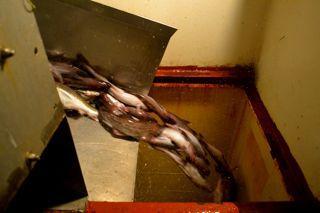Russian Pollock Puts Pressure on Alaskan Market

Thursday, December 15 2011
For the past decade, the Alaskan and Russian pollock fisheries have acted kind of like a seesaw. When the quota for one has been up, the other has usually been down. This year was different though. Both the United States and Russia raised their caps, and the result is that more 6 billion pounds of the fish are expected to be harvested by the end of the year.
The total allowable catch for Russian pollock this year was set at 1.65 million metric tons, while the American quota was put around a million and a quarter metric tons. This supply increase has put a downward pressure on prices for Alaskan fish, which brought about 13 cents a pound this year. Russian pollock commands less value, since it hasn’t undergone the same sustainability certifications that the Alaskan fishery has. That’s in some way a double-edged sword, says Andy Wink. He’s a seafood analyst with the McDowell group who has been tracking the fishery.
He says that on the one hand, the view that Alaskan pollock is a superior product helps it in some marketplaces like Europe, where sustainability is valued. But since Russian pollock is cheaper, it’s also attracting interest from major retailers like McDonald’s which is looking into opening a processing facility in Russia.
“Historically, Alaska product has been worth more in the marketplace,” says Wink. “I think that’s probably what’s behind McDonald’s looking at Russia as a supplier. They’re just trying to find the cheapest supply that they can, which is Russia right now when it comes to pollock.”
But down the road, prices for Russian pollock may go up. The Russian Federation is currently undergoing a Marine Stewardship Council certification which would allow it to better compete with Alaskan pollock. And if a company like McDonald’s is interested in buying their fish, it might encourage other retailers to buy it, too.
“Does that legitimize their fishery? It might to some extent in the eyes of U.S. consumers and maybe even other consumers around the world, since McDonald’s is an international chain,” says Wink. “But they haven’t gotten their MSC certification yet. They’re still going through that process.”
But Alaskan pollock isn’t just competing with Russian pollock. It’s also competing with other whitefish harvested across the country and around the globe. That actually may have a bigger impact on the market for Alaskan pollock in the immediate future, says Wink.
“The supply increase isn’t coming so much from pollock anymore. Looking down the road, it’s coming from things like Atlantic cod and hake. We’re going to have to see whether those harvests really materialize, because if they don’t, it could send people scrambling for product as they’re doing their forecasts of what they expect to buy over the next 12 to 18 months.”
Last year, the first wholesale value of the Bering Sea pollock fishery was estimated at $1.1 billion pounds.



